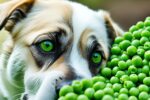Yellow Squash for Dogs: Nutritional Benefits

Many pet owners wonder if it is safe for their dogs to consume yellow squash. The good news is that yellow squash can be a healthy addition to a dog’s diet, providing numerous nutritional benefits. However, there are a few considerations to keep in mind when feeding dogs this vibrant vegetable.
Yellow squash is safe for dogs to eat, as long as the seeds, skin, and rinds are removed. The best types of squash to feed dogs are butternut squash, pumpkin, zucchini, and acorn squash. These types of squash are easily digestible for dogs. Yellow squash is high in fiber, beta-carotene, and vitamin A, all of which have various health benefits for dogs. Squash can improve digestion, hydration, and the condition of a dog’s fur. However, it should be given in moderation and introduced slowly into the dog’s diet. It is recommended to consult with a veterinarian before adding squash to a dog’s diet.
Key Takeaways:
- Yellow squash can be a safe addition to a dog’s diet, but it should be fed in moderation.
- Butternut squash, pumpkin, zucchini, and acorn squash are the best types of squash for dogs.
- Yellow squash is high in fiber, beta-carotene, and vitamin A, which can benefit a dog’s digestion, immune system, and fur condition.
- Before introducing yellow squash to a dog’s diet, it is important to consult with a veterinarian.
- Remove the seeds, skin, and rinds from the yellow squash before feeding it to dogs.
Benefits of Yellow Squash for Dogs
Yellow squash offers numerous nutritional benefits for dogs, making it an excellent addition to their diet. Let’s explore the health advantages that yellow squash brings to our furry friends:
Fiber for Digestive Health
The high fiber content in yellow squash aids in maintaining a healthy digestive system for dogs. Fiber promotes regular bowel movements and can alleviate constipation and other gastrointestinal issues. It helps in regulating their digestion and promotes a healthy gut.
Beta-Carotene and Vitamin A for Immune Support and Vision
Yellow squash is rich in beta-carotene, a pigment that provides its vibrant color. Within the body, beta-carotene is converted into vitamin A, a crucial nutrient for dogs. Vitamin A plays a significant role in strengthening their immune system, improving cell function, and supporting vision. It contributes to their overall well-being and can enhance their ability to fight off diseases and infections.
Vitamin C for Anti-Inflammatory Properties
Yellow squash contains vitamin C, which acts as a natural antioxidant and carries anti-inflammatory properties. This essential vitamin can help reduce inflammation in dogs, relieving discomfort associated with joint issues or allergies. It also supports their immune system, promoting a healthier and more active lifestyle.
Essential Minerals for a Balanced Diet
Besides vitamins, yellow squash is also packed with essential minerals such as calcium, potassium, magnesium, copper, and manganese. These minerals are vital for the proper functioning of a dog’s body. They contribute to strong bones, a healthy heart, and an overall well-rounded diet.
By incorporating yellow squash into your dog’s diet, you can help maintain their physical health, reduce the risk of diseases, and support their overall well-being.
| Nutrient | Amount per 100g |
|---|---|
| Fiber | 1.1g |
| Beta-Carotene | 1200mcg |
| Vitamin A | 570 IU |
| Vitamin C | 17.1mg |
| Calcium | 16mg |
| Potassium | 261mg |
| Magnesium | 18mg |
| Copper | 0.045mg |
| Manganese | 0.13mg |
Feeding Yellow Squash to Dogs: Preparation and Serving
When it comes to serving yellow squash to dogs, there are a few important steps to follow to ensure it is safe and nutritious for your furry friend. Here’s how to prepare and serve yellow squash for dogs:
Choosing the Right Yellow Squash
First and foremost, it’s crucial to buy yellow squash from trusted sellers to ensure its safety. Look for fresh, organic yellow squash that is free from any pesticides or other harmful compounds. This ensures that your dog will be consuming a high-quality vegetable.
Cooking Yellow Squash for Dogs
To make yellow squash easier for dogs to digest, it should be cooked until tender. Avoid using any seasonings or additives, as they can be harmful to dogs. Simply steam or boil the yellow squash until it reaches a soft consistency.
Pro tip: The skin and seeds of yellow squash can be difficult for dogs to digest and may cause digestive issues. It’s best to remove them before serving.
| Step | Method |
|---|---|
| 1 | Wash the yellow squash thoroughly under running water. |
| 2 | Cut off both ends of the yellow squash. |
| 3 | Peel the skin using a vegetable peeler or a knife. |
| 4 | Cut the yellow squash into small, bite-sized pieces. |
| 5 | Steam or boil the yellow squash until it becomes tender. |
Enhancing the Appeal
While some dogs may enjoy eating plain yellow squash, others might need a little extra enticement. You can mash or mix the cooked yellow squash with other ingredients such as cooked meat or dog-friendly vegetables to make it more appealing to your dog. Just remember to avoid adding any salt, sugar, or other seasonings that can be harmful to your furry friend.
Combining Yellow Squash with Balanced Dog Food
Yellow squash should never be the sole source of food for dogs. It should be incorporated into their diet as a healthy addition alongside balanced dog food or meat. This ensures that your dog receives a well-rounded and nutritious meal.

By following these steps, you can safely prepare and serve yellow squash to your dog, providing them with a nutritious and delicious treat.
Conclusion
Adding Yellow Squash to a dog’s diet can be a healthy and beneficial choice. The nutritious properties of yellow squash provide various health benefits for dogs, including improved digestion, immune support, and overall physical well-being.
To ensure the safety of yellow squash for dogs, it is essential to remove the skin and seeds before serving. Cooking the squash without any seasonings or additives is recommended to avoid any potential digestive issues. Yellow squash should be served in moderation and combined with balanced dog food or meat to maintain a well-rounded diet.
Prior to introducing yellow squash or any new food to a dog’s diet, consulting with a veterinarian is advisable. They can assess the individual needs of the dog and provide guidance on portion sizes and frequency of feeding yellow squash.
By incorporating yellow squash into a dog’s diet, pet owners can contribute to their beloved companion’s overall health and well-being. Remember, a balanced and varied diet is key to keeping dogs healthy and strong.
FAQ
Can dogs eat yellow squash?
Yes, dogs can eat yellow squash. However, it is important to remove the seeds, skin, and rinds before feeding it to them.
What are the best types of squash for dogs?
The best types of squash to feed dogs are butternut squash, pumpkin, zucchini, and acorn squash. These types of squash are easily digestible for dogs.
What are the nutritional benefits of yellow squash for dogs?
Yellow squash is high in fiber, beta-carotene, and vitamin A, which have various health benefits for dogs. It can improve digestion, hydration, and the condition of a dog’s fur.
How should yellow squash be prepared and served to dogs?
Yellow squash should be cooked until tender, without any seasonings or additives. It is best to remove the skin and seeds before serving. Yellow squash can be mashed or mixed with other ingredients to make it more appealing to dogs.
Can yellow squash be the sole source of food for dogs?
No, yellow squash should not be the sole source of food for dogs. It should be combined with balanced dog food or meat to ensure a well-rounded diet.






